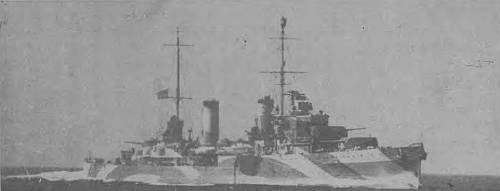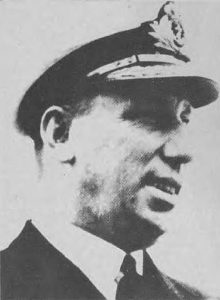- Author
- Holmes, L.F.
- Subjects
- Biographies and personal histories
- Tags
-
- RAN Ships
- None noted.
- Publication
- September 1974 edition of the Naval Historical Review (all rights reserved)
Perth saw a lot of that ‘big’ little ship HMAS Stuart and her famous skipper Captain H. M. L. Waller in this period, and neither Perth’s crew nor Stuart’s captain could guess of the union later to take place and the events to quickly follow.
During a massive air raid on Malta where Perth was berthed alongside, and the transport Essex laden with ammunition just astern, things got so hot that the order was given to leave the ship, and in the general melee Seaman Gee mislaid the Commander’s megaphone, much to the chagrin of that harassed officer!
The Essex was hit and commenced burning furiously but good work by Perth’s firefighters stopped the enormous detonation that was imminent, and a letter of thanks was duly received by Perth from a grateful Governor of Malta. Seaman Gee saw the survivors of HMS Kelly, including her captain. Lord Louis Mountbatten, landed at Alexandria in May 1941, little dreaming that he was to meet this famous personage, half a world distant and in very different circumstances, some years later.

Because of the heavy bomb damage suffered during the withdrawal from Crete, Perth was replaced by Hobart in mid-1941 and returned to Australia for repairs. On October 24, after repairs had been effected, Captain H. M. L. Waller assumed command of Perth. Seaman Gee recalls that the ship was engaged in anti-aircraft practice in Port Philip Bay when news of Sydney’s tragic loss was received.
A few days after Pearl Harbour, Canberra and Perth sailed from Sydney to Brisbane and then to the vicinity of New Caledonia to meet an American convoy bound originally for the Philippines but then diverted to Brisbane. Perth’s next job was to escort the Aquitania and two other transports to Port Moresby in company with Australia, Canberra and Achilles. Alan recalls that these troops, mainly militia, were the men that met the Japanese on the Kokoda Trail.
Perth left Sydney for the last time on January 31 1942, proceeding via Melbourne and Fremantle to the ABDA area in those grim days when the Japanese were carrying all before them.
Perth met that veteran of the Graf Spee action, HMS Exeter, in Tanjong Priok and sailed with her and the British destroyers HM Ships Jupiter, Electra and Encounter (screen to the ill-fated Prince of Wales and Repulse) to Surabaya to join the main ABDA force.
A few days later came that encounter known later as the Battle of the Java Sea, when the ABDA units under the Dutch Rear Admiral K. W. F. M. Doorman met a Japanese force escorting the Java invasion convoy in what Sir Winston Churchill described as ‘the forlorn battle’.
Perth and the US heavy cruiser Houston, as the only large units left intact, broke off the uneven contest and made for Tanjong Priok to refuel and then make a dash for survival, and at 7 p.m. on February 28 both ships cleared that port for Tjilatjap on the safer south coast of Java via the Sunda Strait.

Alan said a feeling of great trust and confidence in Captain Waller’s ability to lead them to safety prevailed in Perth, surely no higher compliment could not be given a commanding officer.
Alan Gee was service helmsman and Captain’s bugler when the ship fought her last battle against overwhelming odds in the Battle of Sunda Strait. He was on the bridge for the whole furious action and was one of the last to see the Captain when the order was finally given to abandon ship.
After spending some time on a raft in an oil-covered sea littered with the debris of the battle, Alan was picked up by an enemy destroyer, transferred to the transport Somdong Maru and later landed in Java to spend some time at Serang before being despatched from Batavia to the infamous Burma-Siam Railway project.
While working on this notorious line, Alan played the Last Post for many of the Allied servicemen who succumbed to the horror conditions which prevailed. ‘This melancholy task,’ he later said, ‘was worse than actually fighting the war.‘
When the war was finally over he was flown from Siam to Rangoon. While in hospital in Rangoon he heard Lord Louis Mountbatten, who was on a visit, ask if there were any seamen present. Alan answered in the affirmative, adding that he had served in Perth alongside Kelly in the Mediterranean. Waving his party on, Mountbatten spent half an hour with Alan in what he calls a memorable experience.
At Singapore on the way home, Alan met Rear-Admiral Patterson on HMS Sussex, his former Captain in Canberra.
As a result of the loss of ninety-two per cent of his vision due to privations endured while a prisoner-of-war, Alan was discharged from the Royal Australian Navy in 1946.
In retrospect Alan Gee says that his service with the Royal Australian Navy has left him with a feeling of great respect and honour towards the service and its traditions.
Recently Alan and his wife took a cruise to Singapore on the liner Patris and were made welcome on the bridge. Passing through the Sunda Strait he had the emotional experience of having the position where Perth went down pointed out to him by the liner’s captain.




